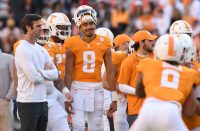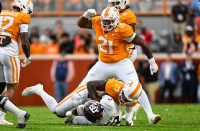Last week, we spent some time looking closely at the importance of size at certain defensive positions. We found that bigger is better along the defensive front and that Tennessee was not only getting bigger, the Vols’ defensive front is likely going to be just as big as Alabama’s and Georgia’s this fall.
All of that made me want to take a closer look at the other side of the line of scrimmage as well. After all, you would think that if bigger is better in the defensive trenches then size would also be important for the guys going up against them.
As I started to gather the information, though, I got sidetracked by noticing something else that may be of equal importance, namely continuity at the offensive line positions. And man, have the Vols had trouble with that.
Offensive line continuity in 2017
The 2017 season was particularly terrible from a continuity perspective. Only two offensive linemen started double-digit games. Trey Smith started all 12, and Jashon Robertson started 10. Drew Richmond — who started 7 games — was the only other player to start more than half the time.
The rest was basically a non-profit board committee. Coleman Thomas started 5, and Brett Kendrick, Ryan Johnson, and Devante Brooks all started 4. Jack Jones and Marcus Tatum each started 3, Riley Locklear started 2, and Venzell Boulware started in one game. That’s 11 different starters at only five offensive line positions.
It’s also ugly when you look at it from a positional perspective. The most stable position was right guard, at which Smith started 8 games. But even that spot was occupied by two other guys for the other four games. Ryan Johnson and Locklear each got the nod twice.
The story is essentially the same at left tackle. Richmond started there for 7 games, but the other five games had Smith there three times and Kendrick there twice.
It just gets worse from there. Here are the starters at center: Robertson (6), Thomas (5), Ryan Johnson (1). At right tackle: Kendrick (5), Brooks (4), Tatum (3).
If you’re keeping count, that’s three different starters at each of the right tackle, right guard, center, and left tackle positions.
But left guard outdid them all. It was a revolving door on Red Bull with six different guys showing up there as starters during the season.
Offensive line continuity in 2018
Things did get better from a continuity perspective in 2018. Three players started double-digit games: Drew Richmond (12), Jahmir Johnson (11), and Ryan Johnson (11). Three more — Trey Smith (7), Jerome Carvin (6), and Nathan Niehaus (6) — started more than half of the games, and Marcus Tatum started five times. Brandon Kennedy started the first game before being lost for the season. Where the Vols rotated in 11 different starters in 2017, they used only eight in 2018.
There was a lot less moving around from position to position last fall as well. Richmond started all 12 games at right tackle, and Johnson & Johnson both started at their respective positions of left guard and center for 11 of 12 games.
Even the other two positions were relatively stable despite having to be manned by more than one guy. Smith started 7 games at left tackle, but when he went out, Tatum took over for the other five. And at right guard, 11 games were handled by only two guys — Niehaus and Carvin. That was the only position occupied by more than two starters over the course of the season, and the third guy filled in for only one game.
Lost in Translation
Admittedly, the improved continuity in 2018 over 2017 didn’t really do much to improve the offense overall last fall. The team was last in the SEC and near the bottom nationally in total offense both seasons. The only real improvement was in Sacks Allowed, which went from 12th in the SEC and 113th nationally in 2017 to 8th in the SEC and 47th nationally. Passing Offense also improved a bit. But most everything else was still a certifiable mess.
This is likely due to the fact that offensive line continuity is only one of many factors impacting offensive line play and that line play is only one of many factors in overall offensive performance. We’ll take a look at some of those other factors in subsequent posts.



